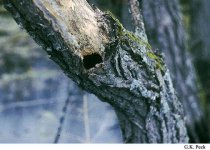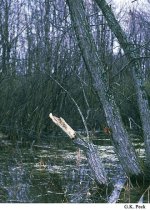BTW, I did some research on the life history of Black-capped Chickadees and found out that their potential life span is 12 years, but they typically perish in their third winter at about 2.5 years.
From that somewhat disturbing fact, I derive the following statistics. A pair has thus typically 2 breeding seasons, typically only 1 brood per season. The clutch size at my locale is 6 to 7 eggs, and the two breeding seasons thus produces 13 eggs. The population is about constant which means that the survival rate from 13 eggs to 2 birds is 2/13 = 15% from first spring to third winter.
Pretty harsh selection, and that's perhaps nature's way of ensuring the survival of the species as such, but I feel sorry for the individual birds. Even the fittest ones freeze or starve to death as soon as they have passed their peak in the second year...





